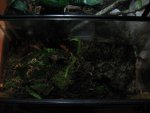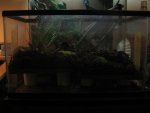Lamb
New member
- Joined
- Feb 28, 2009
- Messages
- 222
- Reaction score
- 12
- Points
- 0
- Age
- 36
- Location
- USA
- Country
- United States
Hello all,
This was my first attempt at building a false bottom tank, but I think I've done something wrong. I gave it what I considered to be a good soaking last night to check the moisture of the soil, and by tonight it was pretty much dry. Too dry for my comfort. When my opacum juvenile gets a little bigger, it will go in the tank. Photos are attached.
Here are the specs: 10 g tank. The bottom is taller on the left than the right (around 7 cm on left). The substrate is a fir/peat moss mixture, along with some sand from the collection sites of the mosses and fern. The tank has a screen top.
When I think about it, I could see the depth of the soil layer being a problem (too thin, perhaps), or the permeability of the screen top being a problem. Or perhaps the false bottom is too tall? I'm not sold on the substrate composition being an issue, as it holds water well in my smaller enclosures without false bottoms. But, as I mentioned, this is my first attempt, and I'd like your suggestions and ideas. Do false bottom tanks typically require more watering than non-false bottoms? Wouldn't the humidity increase if I poured enough water through the soil so that some accumulated in the bottom?
Thanks for the help!
This was my first attempt at building a false bottom tank, but I think I've done something wrong. I gave it what I considered to be a good soaking last night to check the moisture of the soil, and by tonight it was pretty much dry. Too dry for my comfort. When my opacum juvenile gets a little bigger, it will go in the tank. Photos are attached.
Here are the specs: 10 g tank. The bottom is taller on the left than the right (around 7 cm on left). The substrate is a fir/peat moss mixture, along with some sand from the collection sites of the mosses and fern. The tank has a screen top.
When I think about it, I could see the depth of the soil layer being a problem (too thin, perhaps), or the permeability of the screen top being a problem. Or perhaps the false bottom is too tall? I'm not sold on the substrate composition being an issue, as it holds water well in my smaller enclosures without false bottoms. But, as I mentioned, this is my first attempt, and I'd like your suggestions and ideas. Do false bottom tanks typically require more watering than non-false bottoms? Wouldn't the humidity increase if I poured enough water through the soil so that some accumulated in the bottom?
Thanks for the help!


